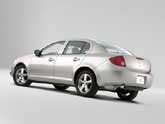Recent Articles
Popular Makes
Body Types
2005 Chevrolet Cobalt
A new variation on vanilla
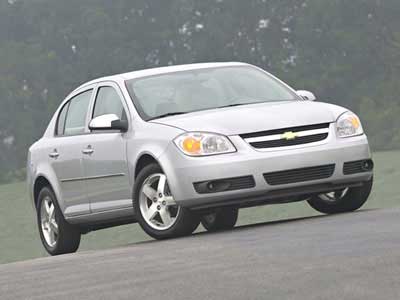
Compact sedans are like vanilla ice cream. Utterly unexciting yet one of the most popular flavors, vanilla is available in many variations and at multiple price points to serve a broad cross-section of consumer needs. Take Breyer’s ice cream, for example. All-natural, wholesome vanilla goodness, Breyer’s has no preservatives or additives. It’s clean, simple, and always gets the job done, kinda like a Honda Civic. Then there’s vanilla bean, creamy smooth like a Toyota Corolla. French vanilla adds pizzazz through color and flavor, like a Mazda 3. And then there’s that six-month-old, half-eaten, freezer-burned box of discount-priced, store-brand vanilla that’s been moldering in the fridge since your sister’s 25th birthday party. Think Chevrolet Cavalier. To distance itself from the stigma of the Cavalier nameplate, General Motors christened its all-new, completely redesigned compact sedan Cobalt. The 2005 Chevrolet Cobalt is still plain vanilla, and though Ben & Jerry might sniff their noses at it, Breyer’s wouldn’t hesitate to slap a couple of mint leaves and red script on this new flavor from GM. Like a Honda Civic, the 2005 Chevrolet Cobalt is clean, simple, and appears poised to get the job done. There’s nothing exciting about it – we didn’t drive the SS Supercharged model – but there’s nothing seriously wrong with it, either. The sticker price, which appears to be deliberately set high enough to preserve profit after incentives and rebates, is too steep. But assuming that big discounts can be had, the new Cobalt makes a case for itself if pizzazz is a low priority.
Lineup
Chevrolet offers the Cobalt in a wide variety of styles and flavors, from budget-friendly commuter to canyon carving sport coupe, enhancing the car’s appeal across a wide demographic. Choose between the 2005 Chevrolet Cobalt coupe and sedan in base, LS, LT, or SS Supercharged trim levels. Coupes can be outfitted with base, LS and SS Supercharged equipment, while sedans are decked out in your choice of base, LS, or LT trim. In 2006, a new SS Sedan debuts with a more powerful motor and other performance upgrades. Standard equipment on base Cobalts includes a five-speed manual transmission, 15-inch wheels and tires, air conditioning, a CD player, a driver information center, a folding rear seat, and a powertrain warranty for five-years/60,000 miles. Cobalt LS adds body-color fascias, power exterior mirrors, cruise control, power windows, power door locks with remote keyless entry, a cargo net, upgraded cloth upholstery, and antilock brakes. Step up to the Cobalt LT for chrome exterior trim, fog lights, aluminum wheels, leather-wrapped steering wheel with audio controls, a storage console between the front seats, and a Pioneer audio system with a subwoofer and seven speakers. The LT also comes with a standard four-speed automatic transmission, traction control, fake wood interior trim, and heated leather seats. Several LT standards are optional on the Cobalt LS. In addition to performance upgrades and styling tweaks, the hot Cobalt SS Supercharged includes titanium-faced sport gauges, floor mats, and color-coordinated cloth inserts for its sport leather bucket seats. The only Cobalt not offered with the five-year/60,000-mile powertrain warranty, the SS Supercharged delivers 205 horsepower and 200 lb.-ft. of torque to the front wheels through a beefed-up five-speed manual transmission. A sport-tuned suspension, four-wheel-disc brakes, and 18-inch wheels wearing 215/45 Z-rated performance rubber are also standard. Key Cobalt options include side curtain airbags, a dubiously titled LS Sport package, OnStar telematics with a one-year Safe & Sound subscription, a power sunroof, XM satellite radio, and Pioneer audio. We spent a week driving a Sandstone Metallic Cobalt LS sedan equipped with just about everything, including an automatic transmission, OnStar, XM, Pioneer audio, a power sunroof, and side curtain airbags. Sticker price, including the $595 destination charge, was a stunning $19,625. Had we been shopping for a car like this, the sunroof, OnStar, XM, and Pioneer audio would be dropped from the window sticker, resulting in a far more palatable, and competitive, $17,730.
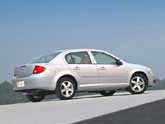
Hardware
The 2005 Chevrolet Cobalt shares a foundation with the poorly received Saturn Ion. Critics, however, applaud the Cobalt as a significantly better vehicle than the Saturn, serving as testament to the power of appealing design and high-quality materials, because the Cobalt drives much like the Ion. Droning from under the hood of our 2005 Chevrolet Cobalt LS sedan was the same 2.2-liter four-cylinder engine found in many General Motors products. This dual overhead cam, all-aluminum, 16-valve engine makes 145horsepower at 5,600 rpm and 155 lb.-ft. of torque at 4,000 rpm running on regular unleaded fuel. On base and LS models, this engine comes standard with a five-speed manual transmission. Our test Cobalt was equipped with the optional four-speed automatic that is standard on the luxed-up LT and which includes a standard traction control system. According to the EPA, these powertrain combinations should get city/highway mileage of 25/34 and 24/32 respectively. We averaged a dismal 22.6 mpg during a mix of city and highway driving. Like the Saturn Ion, the 2005 Chevrolet Cobalt comes with electric drive-by-wire steering, an outdated torsion beam rear axle suspension, and drum rear brakes. ABS is optional on the base model, but comes standard on LS, LT, and SS Supercharged. Base and LS models have 15-inch wheels with 195/60 tires, while the LT gets 16-inch alloys with 205/55 treads. Curb weights range from just over 2,800 pounds for the base Cobalt Coupe to just under 3,000 pounds for the Cobalt LT Sedan. Front/rear weight distribution is 59/41 for sedans and 60/40 for coupes, giving the family four-door a slight nod for balance over the sporty two-door.
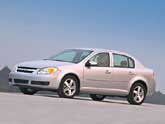
Performance
Stab the 2005 Chevrolet Cobalt’s throttle, and you’ll hear an exhaust note reminiscent of a coffee-canned Civic. Its muted blare is pleasant and sporty, but rising engine revs overpower it with an unrefined droning that doesn’t inspire spirited driving. Even with an automatic transmission, the Cobalt is lively enough around town, but it hates climbing hills despite the fact that the transmission does a good job of holding a steady gear. Stab the 2005 Chevrolet Cobalt’s brakes, and it’s clear that GM has saddled its new econo-car with front disc, rear drum brakes. Four-wheel-disc brakes, which cost more but also deliver better brake pedal feel and stopping performance, are only offered on the Cobalt SS Supercharged. Other Cobalts make due with cheaper and less effective drums, which create the nasty side effect of a grabby brake pedal that offers little feel and is difficult to modulate. When using the mediocre brakes of our test Cobalt while its body was unsettled, such as when threading S-turns or traveling around a rotary, the pedal felt grainy and the brakes resisted application. Handling is better, as long as you don’t take hairpin turns at much more than the posted speed. Our Cobalt LS’s Continental Touring Contact AS all-season tires folded over and begged for mercy, generating plenty of understeer, or push, in tight corners. At least they didn’t howl their discontent…much. The Cobalt’s electric steering is an incremental improvement over previous GM efforts, with decent heft and response. But road feel is still totally MIA. Gratefully, the Cobalt’s middling capabilities are comfortably neutral, helped by predictable weight transition and a suspension that, though not the most modern in design, sticks well unless the car encounters a mid-turn bump, at which point the rear end skitters a bit to one side or the other, depending on which back wheel hit the hole. Ride quality is taut, but not stiff until a big impact slams through the front struts and into the cabin. We didn’t have much fun driving our Cobalt LS Sedan test car, but then, that’s what the SS Supercharged is for. Like the sedan, the SS Supercharged is based on a Saturn Ion, in this case the hot-rodded Red Line edition. Now that’s a fun car, and with the Cobalt’s superior design and materials, the SS Supercharged should be a good time. But a Cobalt like our test car, well, it’s Point A to B transportation.
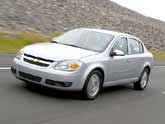
Comfort
Tall people take note: the 2005 Chevrolet Cobalt might prove to be one of the few small cars on the market that you can fit into comfortably. Of course, rear seat passengers won’t have any room, but up front the seat tracks offer more travel than our duo of six-foot-tall test drivers needed. The front seats are firm, upholstered in fabric that looks good and feels durable, and the driver’s seat on our test car featured manual height and lumbar adjustment. All it needed to achieve greatness was a telescoping steering wheel and a tilt feature for the bottom cushion. The Cobalt’s back seat, however, is a penalty box. Don’t let this photo from Chevrolet lead you to believe otherwise, because it was taken with the front seats moved up close to the dashboard. In reality, legroom is limited, foot space is tight, and the rear seatback angle is too vertical for comfort. Making the rear quarters more hospitable are softly padded front seatbacks and a bottom seat cushion that is firm and supportive. Still, adults over average height will not be happy unless front seat occupants are under average height. Tight confines make getting into and out of the Cobalt’s rear seat harder than many competitors, but up front it’s much easier. The Cobalt’s standard 60/40-split folding rear seat must be released from inside the trunk, making expansion of cargo space a two-step process. Liftover height into the 13.9-cubic-foot trunk is high, which means lightly muscled people will probably drag heavy luggage over the bumper, scraping and scratching it in the process. Not only is liftover high, but the trunk opening is also small, though we must note that the Cobalt’s trunk lid is strut supported and includes a nice liner on the inner side of the lid, attention to detail uncommon for the class. One of the nicest things about the Cobalt is how quiet and isolated the cabin is. Wind noise is the only aural irritant until the accelerator is mashed to the floor. Then, the four-cylinder’s whine is audible. So quiet is the Cobalt that when we came to a stop at intersections, we could hear the gasoline sloshing about in the tank. But to its detriment, the quiet interior also made numerous buzzes and squeaks more apparent when the Cobalt traversed rough patches of road.
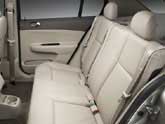
Interior
In the 1950s and 1960s, GM was a design powerhouse under the leadership of a stylist named Bill Mitchell. Today, the Cobalt and other recently introduced GM models clearly indicate that the automaker is figuring out what makes segment leading products tick, if not how to innovate. Inside, the 2005 Chevrolet Cobalt is nearly flawless in design. It’s not exciting, but this interior represents a quantum leap over the hoary old Cavalier and is above par for the compact class. Clearly, GM realizes that it must spend time, money, and effort creating great interiors because that’s where you spend the most time. As proof, check out the matte-finish plastic surfaces inside the Cobalt. Look at the lovely mesh cloth headliner that would be perfectly at home in an Audi. Examine the graining and tones of the various panels and delight in the fact that they either match or are visually complementary. Use the stalks, which no longer feel like saplings snapping under your fingertips. Press the buttons, which all feel solid and refined in action. See how the restrained use of chrome trim gives the Cobalt a just-right degree of sophistication and class. Pictured above is the Cobalt LT with its fake wood trim. On base, LS, and SS Supercharged, it’s replaced by metallic-look plastic. Not only is the Cobalt’s cabin appealing, but it’s also assembled with care. We found nary a nit to pick, no matter how much poking and prodding we did. Our Cobalt test sample represented extraordinary build quality for GM, and for small cars in general. Likewise, the layout and design of the controls represents the simplicity and ease of use that anyone can appreciate. The stereo has big volume and tuning knobs, as well as a nice dot-matrix display that keeps information from appearing like a 1980s Casio digital watch. The climate controls are three simple rotary knobs that are easy to see and use. All secondary controls are located right where you expect to find them, are logically labeled, and work with a degree of refinement usually reserved for Asian competitors. Plus, at night, everything is lit up like a Christmas tree, making features and functions easy to find in the dark. Now, if Chevy could just do something about the Cobalt’s cloying GM new-car smell, which instantly calls to mind every beaten-up, base-model rental car from Avis and National you’ve ever had the displeasure to drive.

Exterior
Stylistically, we take issue with the Cobalt’s excessive front overhang and the tiny little 15-inch wheels on base and LS models. The small wheels make the Cobalt look cheap, like a rental car, and the distance between the front tires and the Cobalt’s nose is not proportional to what’s happening at the rear of the car, where the wheels are pushed out toward the back bumper. The Cobalt is better balanced than a Pontiac G6, but isn’t as well proportioned as it could be. Like the interior, the 2005 Chevrolet Cobalt’s exterior quality deserves praise. Panel gaps are almost impossibly tight, like a Honda Accord. And despite the fact that our test Cobalt exhibited a sloppy joint where the front left fender, windshield pillar and door skin met, the outside was almost as impressively assembled as the interior. Pictured above is the Cobalt LT, with larger brushed aluminum wheels, fog lights, and additional chrome exterior trim. It’s amazing what a few little surface details can do for a car.
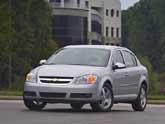
Wrap-Up
Despite deserved praise for the 2005 Chevrolet Cobalt, this car is not likely to age well. First, the hardware is unimpressive, unrefined, and creates a dull driving experience. Let’s hope the upcoming Cobalt SS sedan gets more than just a bigger engine when it arrives for 2006. Second, GM will probably start dumping the Cobalt into rental fleets after the last creaky Cavaliers are wholesaled to the Rent-A-Wrecks of the world. That’s great news for business travelers and vacationers who will no longer need to upgrade for a decent set of wheels, but is likely to depress resale values and exacerbate a negative brand equity equation that already exists among consumers. Third, the price tag is too high. Granted, our Cobalt LS sedan, equipped with just the automatic transmission and side-curtain airbags, would have cost just $17,730, but that’s still in the neighborhood of the fun Ford Focus ZX4 SES, popular Honda Civic LX, value-laden Hyundai Elantra GT, upscale Mazda 3s, and durable Toyota Corolla LE. Boosting the Cobalt’s powertrain warranty was a great move; now GM needs to get the sticker price back in line to create an irresistible value equation. Still, even with tweaks, the 2005 Chevrolet Cobalt might not prove good enough. GM has ignored the compact car segment for too long, and has made too many missteps in the past. Consumers have moved on, and a small Chevy is no longer on anyone’s radar screen. That’s too bad, because the new Cobalt shows that the execs inside Detroit’s Renaissance Center might finally be getting a clue.
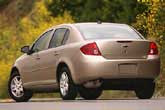
Specifications
Test Vehicle: 2005 Chevrolet Cobalt LS Sedan Price of Test Vehicle: $19,625 Engine Size and Type: 2.2-liter inline four-cylinder Engine Horsepower: 145 at 5,600 rpm Engine Torque: 155 at 4,000 rpm Transmission: Four-speed automatic transmission Curb weight, lbs.: 2,895 lbs. EPA Fuel Economy (city/highway): 24/32 mpg Observed Fuel Economy: 22.6 mpg Length: 180.5 in. Width: 67.9 in. Wheelbase: 103.3 in. Height: 57.1 in. Leg room: front – 41.8 in.; second row – 33.7 in. Head room: front – 38.5 in.; second row – 37.7 in. Max. Seating Capacity: 5passengers Max. Cargo Volume: 13.9 cu. ft. Competitors: Dodge Neon, Ford Focus, Honda Civic, Hyundai Elantra, Kia Spectra, Mazda 3, Mitsubishi Lancer, Nissan Sentra, Saturn Ion, Subaru Impreza, Suzuki Aerio, Suzuki Forenza, Toyota Corolla
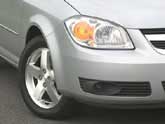
FAQs
Should I take a chance on the 2005 Chevrolet Cobalt? To its credit, Chevrolet has bumped the powertrain warranty on the Cobalt to provide modestly competitive coverage (except for the SS Supercharged) and our test sample was impressively built with few quality flaws. The car is easy to drive, comfortable for front seat occupants, and even stylish depending on what equipment you select. Downsides include unrefined and outdated mechanicals, unimpressive fuel economy, a small back seat, a high liftover into the trunk, and a new-car smell that will remind you more of Avis and National than a vehicle to be proud of. Big rebates and incentives are likely, but despite discounts, unless you buy and drive until the wheels fall off, the Cobalt is not likely to hold its value over time like a Honda or Toyota. Is the Chevrolet Cobalt as good as the critics say? As this is written, Los Angeles is peppered with billboards proclaiming a quote from a reputable automotive publication that says the Cobalt is one of the great new cars for 2005. Under the skin it’s a Saturn Ion, which was one of the worst new cars for 2003. Though the Cobalt is a much better vehicle than the Saturn, mostly because of its superior interior design and amazing build quality, we would not call it one of the best new cars on the market. Rather, it falls mid-pack behind segment leaders like the Honda Civic, Mazda 3, and Toyota Corolla. What would you buy in this segment? Why? Honda Civics are safe, reliable, and hold their value well. Plus, lots of aftermarket parts make them easy to customize. Toyota Corollas are durable, refined, and worth some money after a few years. But the Mazda 3 is our favorite in the class, because we like to drive, and its driving character reminds us of a BMW 3-Series except for a lack of engine power.
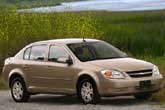
2nd Opinion – Blackett
Frustration. That is the best word to describe my feelings after driving the 2005 Chevrolet Cobalt. But, my angst didn’t have anything (well, not much) to do with the thoroughly competent small Chevy. Rather, I was left questioning GM’s recent decision to move desperately needed funds from their future car programs to launch SUVs over the next few years. If the Cobalt is any indication, GM has finally put some real effort into building a decent , after years of neglecting the segment. Assuming Chevy is able to get buyers into the seat of a Cobalt, when the time comes to trade up those potential repeat customers will be left to choose from a fleet of dated, warmed-over cars like the Buick LaCrosse or brand-new, fuel-guzzling SUVs. Regardless, buyers of the 2005 Chevrolet Cobalt will enjoy build quality that is a notch above rental car quality, a relatively quiet ride, a comfortable driving position, and easy access to everything needed on the daily commute. The 2.2-liter four banger provides adequate acceleration, but despite it’s relatively high (for a small car) 145-horsepower rating, it runs out of steam quickly and is not at all suitable for spirited driving. The four-speed automatic provided smooth shifts. Unlike Wardlaw and Chee, I never heard a pleasant exhaust note from the Cobalt, though I was reminded of the last four-cylinder Chevy Celebrity I drove. The throttle was often fully depressed as I merged onto the highway and worked to pass traffic, and the result was an unimpressive low 20s mpg rating. While the powertrain comes up a bit short, the interior is better than expected. Upon first glance, you’ll notice a lot of plastic panels, but they all feel more solid than in previous GM models, and the bits are securely fastened with no exposed nuts and bolts. Both the parts you touch (dash, door panels, etc.) and those you don’t (lower console panels, pillar covers, etc.) match and offer the same grain pattern. The cloth seat fabric is ok, with the most durable textiles used on the inner parts of the seats. Side bolsters help keep front seat passengers squarely planted. Not that rolling around in the seats should be a problem, because few drivers will feel comfortable in pushing the Cobalt to its limits. The tires and suspension work to provide a pleasant highway ride, but allow for some rolly-polly action in the corners. As Wardlaw mentioned, the rear drums provide for some touchy brakes, but I’ve gotta say that I think the steering in the Cobalt, while not best-in-class, feels leagues ahead of its application in the Saturn Ion. GM has taken a step forward with the 2005 Chevrolet Cobalt, and we hope they find a way to continue onward not only with their small cars, but also with models higher up the food chain. Overall, the Cobalt is a good all-around commuter car with a respectable five-year/60,000-mile powertrain warranty, and if the selling price is where we expect, should prove to be a reasonable value. There may even be enough cash left over to get a sport bike for those twisty back roads. – Thom Blackett
